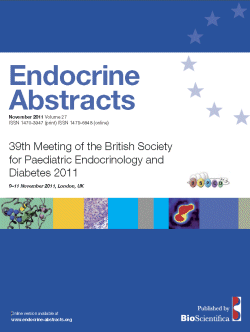
39th Meeting of the British Society for Paediatric Endocrinology and Diabetes
Oral Communications
Oral Communications (RCN CYP Diabetes Session)
ea0027oc5.1 | Oral Communications (RCN CYP Diabetes Session) | BSPED2011
Continuous subcutaneous insulin infusion (CSII) at diagnosis
Potts Louise , Thompson Rebecca , Hindmarsh Peter , Agostini Kirsty
ea0027oc5.2 | Oral Communications (RCN CYP Diabetes Session) | BSPED2011
Investigating vitamin D status as a determinant of HbA1C% in type 1 diabetic paediatric population
Magee Lucia , Mughal Zulf , Ehtisham Sarah , Campbell Judith , Ainsworth Susan , Marshall Marie , Bone Mark , Doughty Ian , Clayton Peter
ea0027oc5.3 | Oral Communications (RCN CYP Diabetes Session) | BSPED2011
Use of Peer review to help individual units and networks improve standards of care
Campbell Fiona , Holland Philip , Heasman James , Bridgeman Ruth
ea0027oc5.4 | Oral Communications (RCN CYP Diabetes Session) | BSPED2011
A network delivered ‘out of hours’ specialist telephone support service for young people and families with type 1 diabetes
Abdullah Nadeem , Van Meijgaarden Birgit , Anand Binu , Arun Sara , Bound Christopher , Cackett Nicola , Pesterfield Claire , Raman Viji , Williams Rachel , Wilson Kate , Acerini Carlo
ea0027oc5.5 | Oral Communications (RCN CYP Diabetes Session) | BSPED2011
Group education facilitation skills for the multidiscplinary team
Gelder Carole , Rodgers Jill , Campbell Fiona , Young Liz



